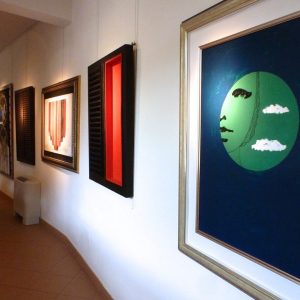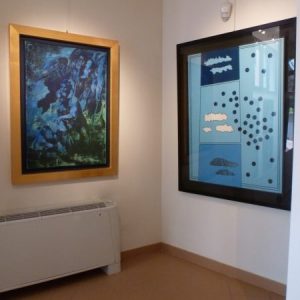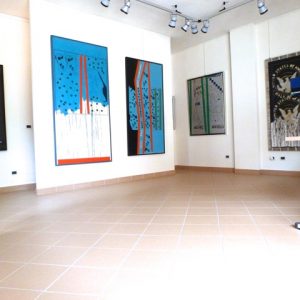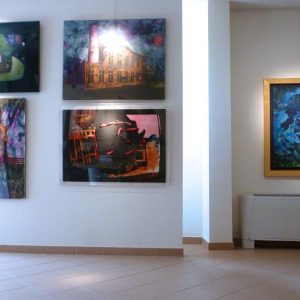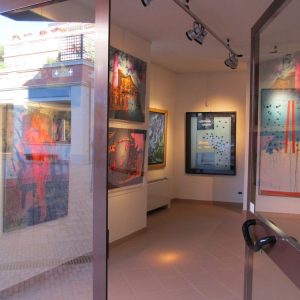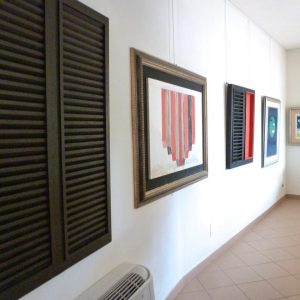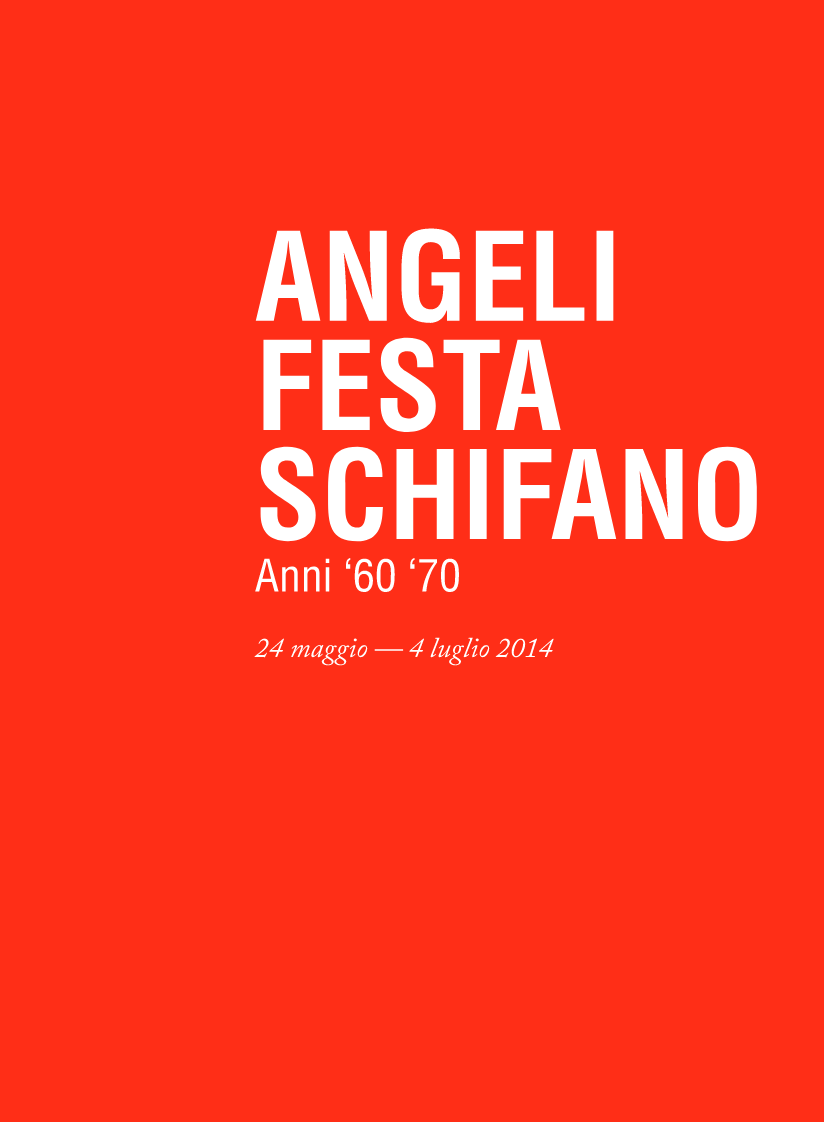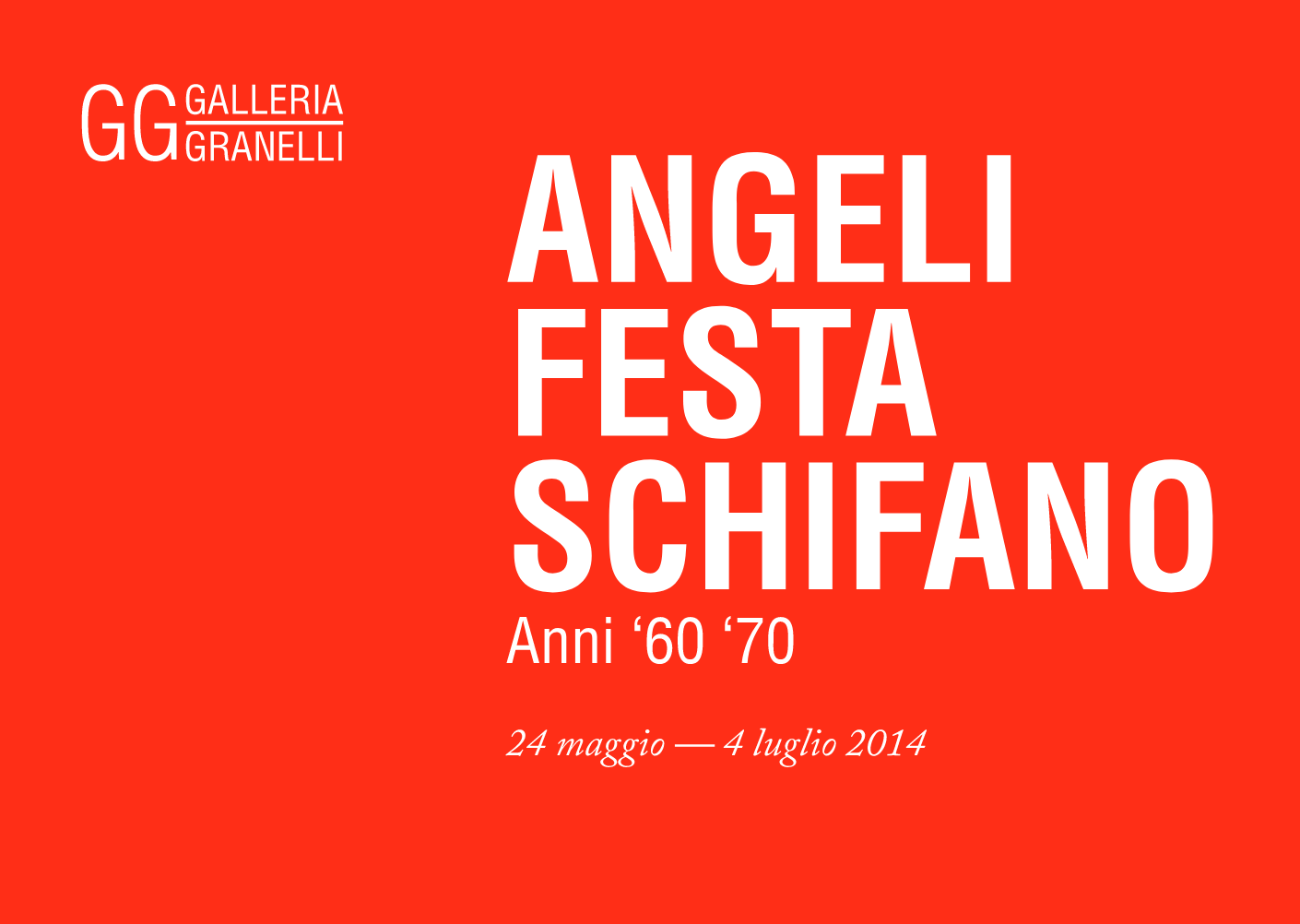
Anni ’60 ’70
24 May – 4 July 2014
“Schifano was with the painters Franco Angeli, Tano Festa, Lo Savio, who all went around the area, in fact then called the Piazza del Popolo school … they were tired, bored, with a stink under their noses, dressed in dark … .The painters who were already in my gallery hated it immediately … because the artists feel the value of another before the critics “(Plinio De Martis).
Galleria Granelli, with the exhibition “ANGELI, FESTA, SCHIFANO 60s 70s” with 30 unique works, returns to pay homage to three autonomous characters in their intuitions and united by a single revolutionary energy: eclectic, unforgettable experimenters of the artistic scene international…
BIOGRAPHIES OF ARTISTS
FRANCO ANGELI was born in Rome in 1935 as a family of humble origins and a solid socialist and anti-fascist tradition. The Christian name is Giuseppe, aka Franco. Third of three brothers, he does not complete elementary studies due to the war.
1941 due to the death of his father, Franco Angeli is forced to provide for his sick mother, inventing the most disparate works: he brings carts to the market, he becomes a brush boy at a barber shop, he works in a laundry, then in a car body shop. Say there, according to Gino De Dominicis, the use of velatine is born.
The stockings, present in the first paintings, are often given as gifts by friends. An excellent upholsterer, he usually prepares the canvases for the paintings himself. He doesn’t go to painting schools and in 1949 his mother dies, an event that marks him deeply. His brother Otello, future secretary of the Communist Party of Cinecittà, educates him according to precise political guidelines. 1957 the first works are born: the need to paint explodes as an affirmation of freedom.
The bombardment of San Lorenzo, which he witnesses as a witness, profoundly upsets him, shaping the future painting where, with the use of materials such as gauzes and dark red colors, they denounce a strong debt to Burri. 1950 Franco Angeli has the first group show, at the Galleria La Salita, in Rome, with Festa and Uncini. 1960 is his first solo show, at La Salita Gallery. His brother Otello organizes the Cinecittà Painting Prize, where a monochrome by the artist, on jute canvas, is rejected by the commission composed, among others, by Guttuso, Trombadori and Del Guercio. Works such as Accattoni, of that year, denote tangents with the poetry of the informal.
1961/62 Franco Angeli participates with Lo Savio, Festa and Schifano in the exhibition New perspectives of Italian painting, at Palazzo Re Enzo in Bologna. He becomes a friend of Schifano, known in the party section: they are united by popular extraction, the rooted sense of reality, the need to go beyond informal experiences. It is a generation of artists united by a close existential bond marked by war: they are called masters of pain, a qualification that distances them from Art Pop, whose extraneousness refers to a letter signed by Angels himself. In the following years he later became a friend of Renato Guttuso and then of Arnaldo Pomodoro and the poet Francesco Serrao.
1963 at the J Gallery in Paris, his works are alongside those of Bruce Conner, Michael Todd, Christo and Kudo: catalog by Pierre Restany. At the Galleria La Tartaruga, in Piazza del Popolo, he takes part in a historic collective: 13 painters in Rome. Angeli’s work is glossed by a poetic text by Nanni Balestrini.
1964, at the L’Arco Gallery of Alibert, in Rome, presents Capitolini fragments: these are wolves, eagles, fragments of collective symbolism. Participate in the Venice Biennale, presented by Calvesi: it is the historic Biennial of Pop Art in Italy. The artist presents The She-wolf and Quarter Dollar. 1965 Franco Angeli is invited to the ninth Roman Quadrennial: of this period are the Partisan Cemeteries, equipped with stars and scythes and hammer. 1967 Franco Angeli present at the Biennial of São Paulo in Brazil with Half dollar: the famous half-dollar, zoomed in details.
1968/70 there is a great political and ideological commitment, which sees him engaged on the theme of the Vietnam War. He meets Marina Ripa Di Meana, on the occasion of the Spoleto Festival. With the woman intertwines a tumultuous relationship which then resulted in faithful friendship. It is she on several occasions who underlines the artist’s profoundly human side, the creativity freed from all market logic, the bohemian life dotted with debts, the desire to die young, untouched by the cynicism that disappointments and disillusionment lead to over time .
1972 presents some interesting works at the Sirio Gallery for the Film review. The face of Marina Ripa di Meana begins to appear in her production, in conjunction with the themes of the plane, the obelisks, the small landscapes. He exhibited at the X Quadrennial in Rome. 1975 He meets Livia Lancellotti, who becomes his companion and will give him, in 1976, a daughter, Maria. He becomes a friend of Jack Kerouac, a bloody crop from a bar where he is expelled drunk. Hosted in the Via Germanico studio, he engages with the artist in the composition of a work The Deposition of Christ, later purchased by Gian Maria Volonté. 1978 participates in the Venice Biennale, curated by Bonito Oliva in the urban iconosphere section. He also presents a short film.
1981 he was invited with some drawings, alongside Dorazio, De Chirico, Fontana, Guttuso, Maccari, Modigliani, Morlotti, Pozzati, and others, to a collective exhibition at the Galleria La Scaletta in Reggio Emilia. 1982 participates in the collective 30 years of Italian art 1950-80, organized at Villa Manzoni, Lecco. He composes works based on the influence of Kees Van Dongen (Thinking of Van Dongen).1984 begins the age of Marionettes, a sort of ironic self-portrait of the artist, then exhibited at the Belvedere of San Lucio. 1986 Franco Angeli participates in the XI Roman Quadrennial. 1988 a retrospective is dedicated to him at the Casa del Machiavelli (1958-72) near Florence. Presented by Marisa Vescovo, she exhibited at the Rinaldo Rotta Gallery in Genoa. He was invited to the Giovanni XXIII Cultural Circle for the Biennial of Sacred Art: with him, Enzo Cucchi, Sandro Chia, Mimmo Paladino and Mario Schifano. In the same year, Franco Angeli died of AIDS at the age of 53. The funeral is celebrated in the Church of Santa Maria del Popolo, chosen by the companion Livia for the boundless love of the artist towards Caravaggio (one of the altars is in fact dominated by The Conversion of Paul).
TANO FESTA was born in Rome on 2 November 1938.
Francesco Lo Savio’s brother, he attended the Art Institute in Rome and graduated in the Art Photography course in 1957. He trained on the example of C. Twombly and of gestural and informal painting. It will not be long before this date that already in 1960 is grappling with his first exhibition, a collective exhibition at Liverani’s Ascent in Rome. In those years the meetings had already taken place: Festa had been a friend of Franco Angeli since the late 1950s, while Francesco Lo Savio was a friend of Mario Schifano.
Fundamental to his career is the participation with Schifano, Baj and Rotella at the show entitled “The New Realist” in New York at the invitation of Sidney Janis. That same year, in 1960 the Odyssia Gallery organized an exhibition of the “new generation in Italy” in New York with Francesco Arcangeli, Valsecchi and Argan. Among the many artists present in that American exhibition: Bendini, Dorazio, Guerreschi, Perilli, Pomodoro, Scanavino and others. Only a couple of years before (1958) Milan had hosted “the new American painting” at the Contemporary Art Pavilion.
They were the beginning of “effervescent” years, years in which Rome seemed to be the city that, better than the others, knew how to interact with the new international artistic inspiration, especially with the USA. The so-called “Scuola di Pazza del Popolo” before to obtain this name by right, it had to wait until 1963, the year in which the Galleria La Tartaruga moved to the aforementioned square, becoming the center of the coagulation of Roman effervescences.On that occasion the gallery owner Plinio De Martiis organized an exhibition that he saw lined up in the walls of the new exhibition space Angeli, Bignardi, Festa, Fioroni, Kounellis, Mambor, Mauri, Novelli, Perilli, Rotella, Saul, Tacchi and Twombly, the title of the exhibition was “13 artists in Rome”. It is the period of the “Objects” by Tano Festa, of the construction, better than the use of the objects extrapolated from the usual context.
In 1964 the first Venice Biennale arrives, where one of his “Persiane”, clearly inspired by Metaphysics and New Dada, is exhibited (for the first time). The choice of the subject is deeply intertwined with the artist’s personal story: the previous year, in fact, Francesco Lo Savio, the elder brother of Tano Festa, had sought death in a hotel in Marseille. His death, felt as tragic and heroic, radically changes the art of Tano Festa who, influenced by a melancholy, almost crepuscular, way of seeing objects around him, underlines the metaphysical value of the objects that mark the boundary of our mortality : not surprisingly Festa reconstructs in wood above all “thresholds”.
In the same early 60s Tano Festa dwells on the masters of the Italian and Renaissance traditions, in particular the Michelangelo della Sistina and the Medici Chapels; intervenes with color on photographs or repaints enamel images projected on the canvas, interpreting them as advertising icons. They are often revived, iterated, in a new disorienting dimension of vaguely surreal climate, but with an immediate suggestion of reading.
In New York he began work on the “Heavens” cycle conducted in Italy and presented in Milan in the exhibition The Planetarium in 1966. In 1966 Milan dedicated an important exhibition to the fiftieth anniversary of Dadaism (1916-1966); Festa was among the invited young painters, and the visual contact with Arp and Man Ray was certainly of extreme significance. In 1967 Festa exhibited at “Arte in Italia 1960-77” in Turin. He inserts again famous icons taken from the history of art in geometric squares or flat-colored masks, without any ironic component, let us think of the modern representations of his “Michelangelo”.
In 1970 Tano Festa marries Emilia Emo Capodilista, with whom he will have two daughters; the marriage will break after three years. The early 1970s saw him transform objects into paintings of objects. Of those years they are the photographic report of a series of squares taken from photos of the Alinari, followed by reproductions of works from the past up to the “periodicization” of fragments of the Sistine Chapel; the photographic report was made both on paper and on canvas in collaboration with the Studio of Mimmo Capone. Participates in two important exhibitions Vitality of the negative (synthesis of Italian art from the 1960s to the 1970s) and Contemporary (international historical panorama from 1955 to 1973), curated by Achille Bonito Oliva.
From 1978 onwards silence descends on Tano Festa, although present in the Biennials and in the most important events, the artist is almost forgotten. Constant commitment and continuous research led him to develop new themes and new languages. Thus, in the early 1980s, Tano Festa will reach the famous Coriandoli which will be a sort of abandonment of the past. With these works he gives a twist to his poetics, somehow breaks with the images of the past to awaken a visionary creation rich in creative vitality, fantasized and always theorized freedom with which it reaches a sublime purity. Tano Festa reconquers critical attention and recognition in this period. In 1980, 1984 Tano Festa is invited to the Venice Biennale. His magic was interrupted on January 9, 1988. In 1989, one year after his death, the monumental “Window on the Sea” was inaugurated, visible on the seafront of Villa Margi, between Palermo and Messina, designed by Tano Festa in memory of his brother Francesco Lo Savio. In 2013 at the Venice Biennale again a recognition for the great Tano Festa.
MARIO SCHIFANO was born in Homs, Libya on 20 September 1934.
After the family moved to Rome, the young Schifano first worked as a clerk and later joined his father, an archaeologist and restorer at the Etruscan Museum in Valle Giulia. Meanwhile he began his artistic career as a painter. His debuts are in the field of informal culture with highly thick canvases, furrowed by careful gestures. With works of this kind he inaugurated his first solo exhibition in 1959 at the Appia Antica Gallery in Rome. It is however on the occasion of the 1960 exhibition at the La Salita Gallery in the company of Angeli, Festa, Lo Savio and Uncini, that the critics began to take an interest in his work. Having abandoned the informal experience, he now paints monochrome paintings, large papers glued on canvas and covered with a single color, tactile, superficial, dripping.
The painting becomes a “screen”, a starting point, the space of a denied event in which, a few years later, figures, letters, fragments of consumerist civilization will emerge, such as the Esso and Coca-Cola marks. In 1962 Schifano is in the United States; he knows Pop Art up close, he is struck by the work of Dine and Kline; his works will be exhibited at the Sidney Janis Gallery in New York in the exhibition “The New Realist”. He will return to the United States at the end of 1963, after setting up several solo shows in some of the major European cities (Rome, Paris and Milan).
In 1964 he was invited to the Venice Biennale for the first time. The artist now works for thematic cycles: the anemic landscapes, the revisitation of the history of art and towards the end of 1964 accentuates that interest in the revisitation of the history of art that I will bring, the following year, to the well-known pieces dedicated to Futurism. In the same year 1965 he realizes “lo sono infantile”, a work linked to illustrations for childhood, which also represents the return – all mental – to a distant temporal dimension, yet always present in Schifano’s art.
He is attracted by the images that can be taken from the mass media and therefore the heritage of the community. This phase of Schifano’s work is occupied by careful critics, such as Maurizio Calvesi, Maurizio Fagiolo and Alberto Boatto, as illustrious writers, such as Alberto Moravia and Goffredo Parise. At Studio Marconi he presented in 1967 the feature film “Anna Carini seen in August by the butterflies”, which will be followed by the trilogy of films composed of “Satellite”, “Human not human”, “Transplant”, “consumption and death of Franco Brocani”.
His first cinematographic experiences, carried out in parallel with the pictorial ones, date back to 1964 anyway, and from these it immediately shows the critical attention that the artist lends to the uninterrupted flow of images produced by our technological civilization in which the real is always replaced. from his “double”, be it photographic or television or film. Between 1966 and 1967 he produced the series “Oxygen oxygen”, “Oasis”, “Tuttestelle” “Companions, companions”. Participate in a collective exhibition at the La Salita Gallery where he does not exhibit paintings but projects photograms on the Vietnam War.
And it is precisely the interest in contemporary history and his civil commitment that will lead him to an ideological and identity crisis that declares he wants to abandon painting. In 1970, together with Tonino Guerra, screenwriter of Carlo Ponti, he went for the last time to America, to carry out the film’s location inspections, “Human Laboratory”, which was never realized. Back in Italy, impatient with the long times of cinematographic dynamics, the series TV Landscapes begins where he transfers the images on canvas with the photographic emulsion technique. Initially it is photographs taken in the United States that are being reworked (which will give rise to works such as the Pentagon, Medal of Honor, the Nuclear Era, the transplant rooms in Huston, NASA, Alamo Gordo from the Los Alamos Archive), then the heritage of images that television stations broadcast daily and incessantly. It is not the TV culture that interests him, but the culture that develops from the television image. He travels to Laos and Thailand, and later to Africa.
In the elaboration of the works the artist prefers the use of colors of industrial production for their ability to preserve the initial brilliance and to dry quickly, allowing him to paint the image in the quick instant of his appearance and a production of more extensive works. The “Homages”, a cycle of work that opens and closes in the 70s, represents a moment in which Schifano’s activity turns towards the same history of painting, an eminently contemporary story, which is reinterpreted and revitalized . In 1971 he participated in the exhibition “Vitality of the Negative in Italian Art 1960-70”, curated by Achille Bonito Oliva; later he held solo shows in Rome, Parma, Turin and Naples and was present at the X Rome Quadrennial and Contemporanea, an exhibition set up in the Villa Borghese parking lot, again in Rome and again by Bonito Oliva.
In 1974 the University of Parma dedicated to him a vast ontology of about 100 works that allowed him to read his entire pictorial adventure and define its bearing lines. The Palazzo della Pilotta (Salone delle Scuderie) in Parma hosts the first major Schifano retrospective , edited by Arturo Carlo Quintavalle, which allows to read the full extent of his work. An ideological and existential crisis forces him to periods of isolation in his studio where he realizes “d’après” reinterpreting Magritte, De Chirico, Boccioni, Cézanne, Picabi. In 1976 Schifano participates in the National Gallery of Modern Art in Bologna at the exhibition “Europa / America, the abstraction determined 1960-76 “. In 1978 he was invited again to the Venice Biennale with the series “Al mare” and “Quadri equestri”, works painted with extreme grace and lightness, constitute the example of a rediscovered creative freshness. He presents “The unknown masterpiece” at the Rome Turtle, a reworking of the famous Balzac tale of the same name.
In 1979 several of his works were on display at the Palazzo dei Diamanti in Ferrara, while the following year he was invited by Maurizio Calvesi to the exhibition “Arte e critica 1980”, set up at the Palazzo delle Esposizioni in Rome. In 1981 Germano Celant selected some works by Schifano for the “Identitè italienne” exhibition organized at the Center George Pompidou in Paris. The cycles entitled “Architectures”, “Cosmetics”, “Biplanes” and “Botanical Gardens” are from that period. His works appear in the avant-garde / Transavantgarde at the Aurelian Walls of 1982. Marco Meneguzzo curates a solo show at the Loggia Lombardesca in Ravenna.
He conceives a sequence of large paintings including Bicycles and Dancers. He is present at the 1982 and 1984 editions of the Venice Biennale. In this period he also held personal exhibitions at the Palais des Beaux-Arts in Brussels and at the Contemporary Art Pavilion of Ferrara, where, under the title “Invent with soul and without a soul”, he collected a series of paintings representing the summa of his naturalistic research. This last exhibition will then become itinerant, touching several Italian cities, to finally arrive in France, at the Center d’Art Contemporain of Saint Priest (1992). Attention to nature characterizes all of Schifano’s current research: landscapes, water lilies, wheat fields, movements of the sea, stretches of sand are recreated, reinvented, filtered through memories, impulses, sensations, outcrops of the deep, sequences of images conveyed by television sets, by advertising, by magazines, and are therefore configured as geographies of memory. In 1985 in Florence, in Piazza Santissima Annunziata, he painted La chimera in front of six thousand people, a monumental work of four meters by ten, inaugurating the exhibition on the Etruscans.
He married Monica De Bei from whom he had his son Marco, his painting became denser and richer in suggestions. In 1989 he was one of the protagonists of the 20th century Italian art exhibition, organized by the Royal Academy of London. His personal exhibitions are held at the Palais des Beaux-Arts in Brussels and at the Contemporary Art Pavilion in Ferrara. In 1990 the Palazzo delle Esposizioni in Rome, on the occasion of its reopening, dedicated to him a review entitled “Disseminate”, with large-format works created for the occasion. Three years later he presented in several Italian galleries the cycle “Reperti”, dedicated to the animals of the prehistoric world, a theme whose first examples had already appeared in the personal exhibition by Maeght.
The 1993 Venice Biennale, curated by Achille Bonito Oliva, offers him a personal room in the “Slip” section. In 1994 he took part in The Italian Metamorphosis, 1943-1968, organized by the Solomon R. Guggenheim Museum in New York. In 1996 Schifano pays homage to his auxiliary Musa, or television, understood as a continuous flow of images that can be structured as a true and unique totalizing reality of our age. If at the end of the Sixties he confined himself to extrapolating from the television programs of the single frames and projecting them decontextualized on the canvas, now, instead, he intervenes pictorially on the images, changing them even further.
He sets up with about forty such paintings and a thousand hand-retouched photographs, a large exhibition that was first hosted at the Memorial da America Latina Foundation in San Paolo del Brasile (1996), then at the Fine Arts Museum in Buenos Aires (1997); during 1998 it will be presented at the Wifredo Lam Foundation in Havana and in Mexico City.
The works of these years testify to his interest in science and technology, the Stet commissions him to design the integrated image of society, Schifano immediately seizes the possibilities of the Internet which, with its unlimited access, extends the expressive possibilities of the visual arts, the novelty of optical fibers that speed up communication, so as to dedicate a work that becomes its symbol. During one of the trips to Brazil he makes a happening in the favela of Rio de Janeiro, painting a white shack as a protest against the mayor’s disposition to paint all the favelas green to make them uniform and “invisible”.
In 1997 he took part in Minimalia held at the Palazzo Querini Dubois in Venice. In the same year, on the occasion of the seventh centenary of the construction of Santa Croce in Florence, Schifano obtained the San Giorgio di Donatello Award for having created the polychrome stained-glass windows located in the crypt of the Basilica. Schifano died in Rome on 26 January 1998.
THE POP ART
Pop art is an artistic movement that began to take shape in England in 1952 through the works of Hamilton and Paolozzi and then became specific in the United States by Warhol, Linchestein, Dine, Oldenburg, Wesselmann, Rivers, Segal, Rosenquist and developed together in the rest of Europe. Pop art comes from the English word “popular art” or folk art.
Starting from a reflection on their contemporaneity, characterized by the abundance of goods and the increasingly massive presence of the media, pop artists take their materials, images, objects from what they represent in reality to create the work. Pop Art draws its subjects from the universe of everyday life and bases its comprehensibility on the fact that those subjects are absolutely known and recognizable to everyone. In Europe he immediately found great resonance thanks to the 1964 Venice Biennale which represented it in a more spectacular way and which gave Robert Rauschemberg, the jury prize.
European artists take part in the current in a different way than the American ones, finding their own identity. Italians elaborate a language that takes on more humanistic and literary values than pop art, thus reflecting the various cultural autonomies and the sensitivity of individuals.
By proposing each point of view original, heterogeneous, in some cases even critical of American pop art, they create a climate in which overseas influences are filtered through irony and history, the past and the contemporary, culture and memory .
It is part of the Roman group of the Piazza del Popolo School: Tano Festa, Franco Angeli, Mario Schifano, Mario Ceroli, Fabio Mauri, Giosetta Fioroni, Jannis Kounellis; and then again: Valerio Adami, Emilio Tadini, Alik Cavaliere, Lucio Del Pezzo, Titina Maselli, Pino Pascali, Claudio Cintoli, Beppe Devalle, Pozzati Concept, Umberto Buscioni, Renato Mambor, Ugo Nespolo, Sergio Lomberdi, Aldo Modino, Piero Gilardi Michelangelo Pistoletto, Enrico Baj and Domenico Gnoli



